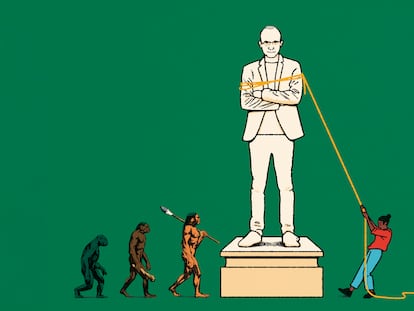Godzilla, Tyrannosaurus rex and Raquel Welch’s bikini: The adventures of a geeky paleontologist
In the book ‘Dinosaurs and Other Animals,’ José Luis Sanz revisits the history of paleontology through its influence on the popular imagination
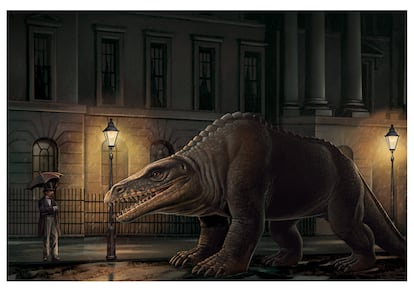

It may seem strange that a serious book on dinosaurs by one of the world’s most renowned paleontologists includes images of Godzilla, or photos of Raquel Welch and Victoria Vetri wearing skimpy bikinis in One Millions Years B.C. or the King Kong films. Even stranger to see drawings of prehistoric animals attacking a submarine, or an encounter between Charles Dickens and a Megalosaurus in the streets of London. The book is also filled with snapshots of the author being attacked by gigantic plastic dinosaur figurines.
All of this and more — including an illustration showing aliens exterminating dinosaurs from their flying saucers — appears in the nearly 600 illustration-filled pages of Dinosaurs and Other Animals, which discusses the field of paleontology and its impact on popular culture. A very entertaining and original book that’s loaded with thoughtful content, it’s authored by José Luis Sanz, professor emeritus of paleontology at the Autonomous University of Madrid.
The 75-year-old Spanish scientist has authored a dozen books on dinosaurs, as well as numerous articles in research journals, such as Nature and Science. He’s also contributed to the design of paleontology exhibits in museums. His latest work — in addition to showing his deep knowledge about terrible lizards and other beasts from the past — also reveals his self-confessed status of “dinosaur geek.” And what could be more interesting, stimulating and contagious than a prominent dinosaur specialist? A prominent dinosaur specialist who knows how to geek out.
In his work, Sanz highlights the often fruitful and inspiring relationships between paleontology and popular culture regarding dinosaurs. For instance, fiction was actually the first field to show that the dinosaurs weren’t the dumb and heavy brutes that scientists initially envisioned. Sanz takes his readers through the variety of stories that have been created, such as science fiction about time travel to visit the dinosaurs, or tales about ancient creatures who have survived in remote places. Oftentimes, these stories involve dinosaurs visiting our cities, resulting in a mess (a favorite theme of so many movies).
How Sanz managed to convince his publisher to print this beautiful volume — whose idea and production costs must have perplexed the editors — is a mystery. A mystery almost as big as what a Tyrannosaurus rex’s little hands were used for. In the work, the author alternates between scientific discourse and the history of the relationship between dinosaurs and popular culture, presenting a sensational display of images that includes photos, drawings, priceless illustrations from books and magazines, newspapers, vignettes, comics, movie stills, movie posters, old prints, trading cards and even candy bar wrappers. There are monsters such as Gorgo, Rodan, the mokele-mbembe and, of course, Godzilla. All of these images, however, are accompanied by refined scientific reconstructions, graphs, maps and other academic materials.
Renowned scientific illustrator Xavier Macpherson has captured some of Sanz’s most unique ideas with spectacular drawings, such as the double-page ones of St. Hilda of Whitby turning the snakes that infested Yorkshire into stone, or the immense Mosasaurus trapping a specimen of Placenticeras ammonites. He also shows us a colony of pink flamingo-like Pterodaustra pterosaurs, the birth in the sea of an Ichthyosaur, a Stegosaurus with a zebra-type camouflage pattern, or a Tyrannosaurus rex with three young offspring. Also noteworthy are the posters and book covers that Macpherson and Sanz have invented, such as the poster for Flaming Cliffs — an invented film about the paleontological adventures of Ray Chapman Andrews in the Gobi Desert, with Charlton Heston playing the scientist (who, by the way, was one of the inspirations for Indiana Jones). The two men certainly had a great time.
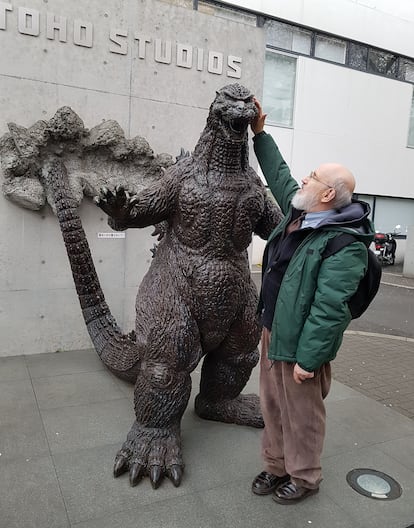
“I admit that there’s a bit [of messing around],” Sanz laughs. “In this kind of book — with all that we wanted to discuss — we had to ensure that the reader didn’t get bored. There had to be some nonsense. The truth is that people who’ve read it say that they had a lot of fun. A little spice was essential, in case someone fell asleep.”
“In previous books,” he continues, “we already discussed the topic of dinosaurs in popular culture. But here, we reversed the percentage — we dedicate much more space to this.” Sanz highlights the great graphic commitment of the volume. “It allows us to show the connection between the two areas: the scientific and the popular. It was very important to illustrate popular ideas. I spent almost three months in the Library of Congress in Washington reviewing newspapers from the last decade of the 19th century and the first two decades of the 20th, the period in which the dinosaur boom in popular culture really began. This is central to the book. Many of the common ideas about dinosaurs were born at that time: that they were big, terrible, that they may still exist, that they look like dragons... these ideas of dinomania were created then, in parallel to the advance of scientific [knowledge] and, at times, also interacting with it.” The book includes illustrations from the original sources of 19th- and 20th-century paleontology.
“Dinosaurs — as we understand them today — are largely a creation of Victorian and Edwardian society. The first scientific publication about a species was in 1824,” the author notes. “I’ve delved into the sources from that time to build the chapters of the book.”
Macpherson’s illustrations helped him capture some ideas and play with them. One drawing — which shows Charles Dickens next to a Megalosaurus on a London street — accompanies an explanation about how the writer was a good friend of Richard Owen (1804-1892), the inventor of the term “dinosaur.” In one of Dickens’ novels, Bleak House, the author writes:”As much mud on the streets as if the waters had just receded from the face of the Earth, and it would not be surprising to find a megalosaur, about forty feet long, staggering like a mammoth lizard towards Holborn Hill.”
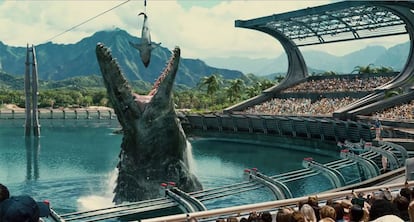
Sanz emphasizes that, while he’s a paleontologist, he’s also a geek. “[Still], there are things that I get very serious about: some points about dinosaurs have to be made very clear. For example, that birds are dinosaurs and that many of these creatures were covered in feathers (or monofilaments that evolved into the feathers of today’s birds), among them such emblematic species as the carnivorous Velociraptor and Deinonychus.” It’s important to remember (and Sanz does, in his book) that Michael Crichton, the author of the novel Jurassic Park, which gave rise to Spielberg’s film, made the Deinonychus his protagonist, changing its name to “Velociraptor.” It’s actually a very similar dinosaur, but it’s much smaller, the size of a turkey: he changed the name because it sounded better.
“The thing about birds and feathers bothers some dinosaur fans, but in paleontology, the hypotheses are contrasted with the fossil record. Today, there’s no paleontologist in his right mind who doesn’t accept the dinosaurian theory (which contends that birds evolved from theropod dinosaurs). The geekism that I don’t share is the one that continues to deny that birds are dinosaurs. I’m a proud geek, but you cannot take paleontological tests at face value.” That said, he clarifies that some paleontologists take themselves too seriously when criticizing some things about dinosaurs in fiction. “Science has limits, but the human imagination does not.”

One surprise in the book is Sanz’s passion for ammonites — extinct cephalopod mollusks — which don’t seem to be comparable to a good old Tyrannosaurus rex. “I love them. Dedicating a chapter to them is breaking [a norm] regarding the paleontology of the invertebrates, who aren’t usually treated very well. [But], for some, ammonites are the quintessence of paleontology. They have something special… the fact that they became extinct gives them, of course, a great charm. They produce a certain tenderness in me.”
Other prehistoric creatures (Sanz detests the term “antediluvian”) pampered in the book are ichthyosaurs, plesiosaurs (a recurring theme in the popular imagination is that some still exist), mosasaurs (large aquatic predators from the Upper Cretaceous) — that went extinct 66 million years old and appear in Aquaman, Jurassic World and The Mandalorian — and the pterosaurs, the wonderful flying reptiles, with representatives as extraordinary as the enormous Quetzalcoatlus. Sanz clarifies that pterosaurs wouldn’t be able to pick people up — as they do in movies and other works of fiction — since they don’t have claws like birds of prey.
In a shift away from dinosaurs, there’s also a chapter on mammoths, in which the author explains that, at the famous dinner at the Peabody Museum of Natural History in 1951, what was served under the name of “mammoth meat” was, in fact, turtle meat.
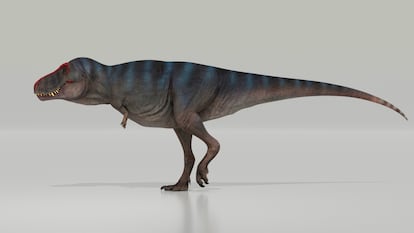
Is Sanz one of those people who, when he watches One Millions Years B.C. (1966), pays more attention to dinosaurs than to Raquel Welch? “I say it in the book: I’m someone who pays attention to the dinosaurs and Raquel Welch. [My love of dinosaurs] hasn’t made me indifferent to her. But I have to say that I adore the person responsible for the dinosaurs in the film — Ray Harryhausen, the great special effects creator — whom I was lucky enough to meet. I’m a big fan of dinosaur movies, as can be seen in the book.”
Sanz agrees with Crichton’s consideration that one of the things that makes dinosaurs so fascinating to us is their size. The most emblematic ones were enormous. “And that they had such strange shapes. Richard Owen already conceived of them as very strange reptiles… not like the current ones, but rather, with a mammalian appearance. Majestic, fearsome. Another factor is that they represent an alternative kind of nature to what we’re used to. They provoke morbidity, fear and attraction. And they look so similar to the creatures of our myths and legends…”

Logically, the Tyrannosaurus rex has a big role in the book. But is this star of the dinosaur world falling for the new generations, with the appearance of other large carnivores? Is the T-Rex going to be dethroned?
“I don’t think so,” Sanz opines. “It’s true that there are other carnivorous dinosaurs as big as him. But there’s something that seems fundamental to me: no possible rivals in popularity of the Tyrannosaurus rex — such as the Carcharodontosaurus — have been found in the United States. And the Tyrannosaurus rex continues to be a very American dinosaur. [The creature’s] popularity has to do with the exporting and colonialist culture of the United States. In some way, the [T-Rex] represents the soul of the nation. One of the last specimens was even excavated by [U.S. combat engineers]. Like the bald eagle, it’s an animal that represents the power and majesty of the United States. And as long as the United States is up there and sets the tone in fiction, the Tyrannosaurus rex will be the epitome of dinosaurs, as it has been since the first film. At the moment, it seems to me that no one is going to dethrone him.”
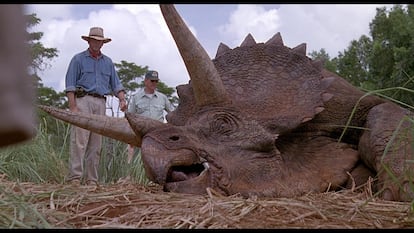
Sanz believes that artificial intelligence — with its ability to handle enormous amounts of data and variables — will make great progress in the field of dinosaur reconstructions. He also hopes that means will be found to obtain dinosaur DNA. Regarding the issue of the disappearance of dinosaurs (the non-avian ones, he emphasizes), he considers the hypothesis of the meteorite impact valid. “[The sudden mass extinction] that took place 66 million years ago is enough to explain everything we observe in the fossil record. Nothing more is needed.”
However, he acknowledges that there’s still “no idea” about “why the extinction of dinosaurs was so radical. How come mammals didn’t disappear? It remains an enigma.”
It’s important to remember that this was not the worst extinction on Earth. The Permian-Triassic extinction event — which took place 250 million years ago — resulted in the Great Dying, in which three-quarters of all species disappeared. “When Stephen Gay Gould (a famous American paleontologist) was asked how close life was to completely disappearing then, he simply put his thumb and forefinger together: that’s how close it was. It was a tough extinction.”
When asked about his favorite dinosaur movie scene, he replies: “When Grant and Dr. Sattler caress the sick Triceratops in Jurassic Park, it’s shown — and this is how the audience perceives it — that the dinosaurs were normal animals, who pooped and pooped. They had stomach aches like everyone else.” As for what he would like to see in person from the age of the dinosaurs, he answers that he wishes he could see the precise moment in which the first land animal took off, flapping its wings. “That’s where the paleontologist can be a geek. As a geek, I would perhaps choose to see a Tyrannosaurus rex… but the first [event] is more useful. And the Tyrannosaurus will soon be shown to me in a very [lifelike] way in the movie theater.”
Sanz’s favorite fictional paleontologist is the one in the first Godzilla movie, from 1954: Dr. Kyohei Yamane. “He gives a very moving speech about the animal and its origins to the Japanese government.”
Sign up for our weekly newsletter to get more English-language news coverage from EL PAÍS USA Edition
Tu suscripción se está usando en otro dispositivo
¿Quieres añadir otro usuario a tu suscripción?
Si continúas leyendo en este dispositivo, no se podrá leer en el otro.
FlechaTu suscripción se está usando en otro dispositivo y solo puedes acceder a EL PAÍS desde un dispositivo a la vez.
Si quieres compartir tu cuenta, cambia tu suscripción a la modalidad Premium, así podrás añadir otro usuario. Cada uno accederá con su propia cuenta de email, lo que os permitirá personalizar vuestra experiencia en EL PAÍS.
¿Tienes una suscripción de empresa? Accede aquí para contratar más cuentas.
En el caso de no saber quién está usando tu cuenta, te recomendamos cambiar tu contraseña aquí.
Si decides continuar compartiendo tu cuenta, este mensaje se mostrará en tu dispositivo y en el de la otra persona que está usando tu cuenta de forma indefinida, afectando a tu experiencia de lectura. Puedes consultar aquí los términos y condiciones de la suscripción digital.
More information
Archived In
Últimas noticias
Chris Martin, Taylor Swift, Elijah Wood and other famous wedding ‘crashers’
‘How does it feel to be a failure?’: Elizabeth Berkley’s journey from ‘Showgirls’ ridicule to vindication
The story of the Málaga virus: The code that haunted Google’s cybersecurity center director for 30 years
The impact of Ecuador’s mega-prison: A polluted river, cleared forests and military checkpoints
Most viewed
- Christian Louboutin: ‘Young people don’t want to be like their parents. And if their parents wear sneakers, they’re going to look for something else’
- The low-cost creative revolution: How technology is making art accessible to everyone
- Liset Menéndez de la Prida, neuroscientist: ‘It’s not normal to constantly seek pleasure; it’s important to be bored, to be calm’
- All the effects of gentrification in one corner of Mexico’s Colonia Roma
- December Social Security and SSI payments: Dates, double checks and the 2026 COLA increase

